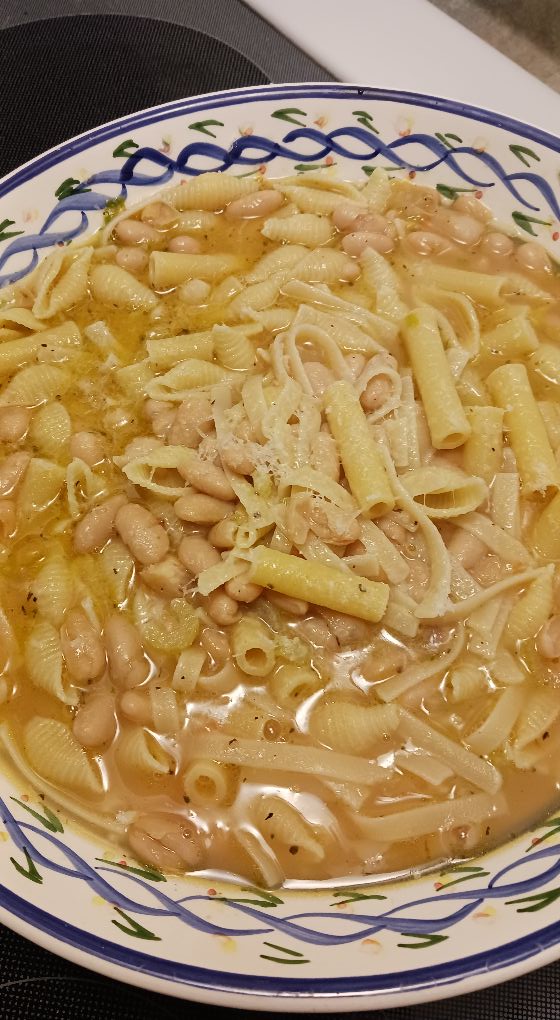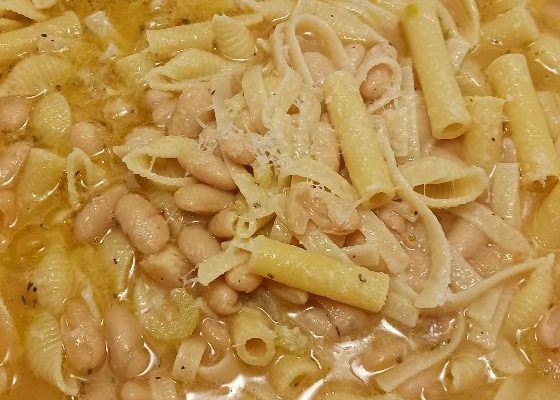Pasta Fagioli, meaning “pasta and beans” in Italian, is a soulful dish that beautifully captures the essence of rustic Italian home cooking. This humble yet deeply satisfying soup has its roots in the countryside kitchens of Italy, where simple, everyday ingredients were transformed into nourishing comfort food.
The combination of creamy cannellini beans, tender pasta, fragrant garlic, and aromatic celery creates a hearty meal that feels both familiar and timeless.
Each spoonful is a reflection of Italy’s culinary philosophy — wholesome ingredients, patience, and a touch of love. Whether served as a light dinner or a cozy lunch, Pasta Fagioli wraps you in warmth, bringing the heart of an Italian kitchen straight to your table. It’s the kind of meal that invites you to slow down, savor, and say, “Buon Appetito.”

Why People Will Love Pasta Fagioli (Buon Appetito):
Rustic Italian Comfort – It embodies the essence of traditional Italian home cooking, transforming simple beans and pasta into a soul-warming dish.
Rich, Layered Flavors – The garlic, celery, and spices slowly infuse the beans and broth, creating a depth of flavor that is both hearty and aromatic.
Wholesome and Nourishing – Packed with protein-rich beans, fiber, and wholesome pasta, it’s both filling and deeply satisfying without being heavy.
Versatile Tradition – Every household in Italy makes Pasta Fagioli differently, meaning this dish invites creativity while staying rooted in authenticity.
Affordable Elegance – Made with everyday pantry staples, it proves that comfort and richness don’t require expensive ingredients.
Textural Harmony – The creamy beans, tender pasta, and gentle chew of celery deliver a perfect balance in every bite.
Timeless Connection – It carries with it a sense of heritage and nostalgia, reminding people of family gatherings, old-world traditions, and the warmth of shared meals.
Key Ingredients:
Cannellini Beans – Creamy, tender, and slightly nutty, they form the heart of this dish, bringing both nourishment and silky body to the broth.
Garlic & Celery – A humble duo that lays the foundation of flavor, slowly releasing their sweetness and aroma into the simmering pot.
Olive Oil – Liquid gold of the Mediterranean, it enriches the dish with warmth and depth, binding every flavor together.
Pasta – Simple yet soulful, the pasta gives the soup its comforting texture, turning it into a true “cucina povera” classic of sustenance and love.
Parmesan Rind – A secret ingredient that infuses subtle umami richness, elevating the broth into something far greater than the sum of its parts.
Expert Tips:
Build flavor slowly at the base – Take your time sautéing garlic and celery in olive oil. The gentle heat coaxes out sweetness from the celery and mellows the garlic, creating a soulful foundation that carries through the entire dish.
Do not drain the beans – The starchy liquid from canned cannellini beans is not waste; it’s a natural thickener that deepens the body of the broth and gives Pasta Fagioli its creamy, rustic character without adding cream.
Respect the pasta cooking water – The salty, starchy water is a gift. Adding a little at a time allows you to control the consistency, moving from a thicker stew-like bowl to a looser, soupier version depending on your preference.
Let Parmesan do its quiet work – If you have a rind, slip it into the simmering pot. It doesn’t melt away but releases subtle layers of umami and salt, transforming the broth into something unforgettable.
Balance with restraint – Resist over-seasoning with tomato sauce or spices. Pasta Fagioli is about harmony: beans, pasta, and aromatics woven together. A spoonful of tomato or a pinch of red pepper should lift, not overwhelm, the earthy simplicity.

Pasta Fagioli. Buon Appetito
Ingredients:
5 cloves garlic, crushed
4 stalks celery, chopped (with leaves)
2 tablespoons olive oil
1/4 teaspoon crushed red pepper flakes (adjust to taste)
1/2 teaspoon Italian seasoning
Salt and black pepper to taste
2 cans cannellini beans (do not rinse or drain)
1 cup pasta: we use different kind of pastas, this is how I was taught as a little girl in Italy. Not always but it’s fun. They even sold packages of Pasta with different shapes just for pasta fagioli.
Parmesan cheese rinds (optional)
1 spoonful tomato sauce (optional)
Parmesan cheese for serving
Reserved pasta water (from cooking pasta)
Instructions:
Sauté Aromatics:
In a large pot, heat the olive oil over medium heat. Add the crushed garlic and chopped celery. Sauté slowly until the celery is tender and the garlic is fragrant, about 5-7 minutes.
Season:
Add salt, black pepper, crushed red pepper flakes, and Italian seasoning to the pot. Stir to combine and cook for another 1-2 minutes.
Add Beans:
Add the two cans of cannellini beans to the pot (without rinsing or draining). Stir well and let simmer for about 30 minutes, allowing the flavors to meld together.
Cook Pasta:
While the beans are simmering, cook the pasta according to package instructions. Reserve a cup of pasta cooking water before draining.
Combine Ingredients:
Add the cooked pasta to the pot with the beans. If desired, add Parmesan cheese rinds and a spoonful of tomato sauce for added flavor. Stir to combine.
Adjust Consistency:
Gradually add reserved pasta water to reach your preferred soup consistency. Stir well and let simmer for an additional 5-10 minutes.
Serve:
Ladle the pasta fagioli into bowls. Top with freshly grated Parmesan cheese and a sprinkle of additional Italian seasoning if desired.
Enjoy:
Serve hot and enjoy this comforting, traditional Italian soup!
Important Notes When Making Pasta Fagioli:
Texture defines tradition – Pasta Fagioli should not be a thin broth but rather a rustic, hearty soup where the beans and pasta create a creamy body. Adjust consistency by adding or reducing pasta water, but aim for a balance where spoonfuls feel substantial, not watery.
Pasta timing is crucial – Always cook the pasta separately and stir it in just before serving. If added too early, it will continue to absorb liquid and become mushy, changing the soup into a heavy stew. Leftovers especially benefit from keeping pasta and beans separate until reheating.
Bean quality matters – Cannellini beans are classic for their creamy flesh and nutty flavor, but navy or borlotti beans can be used for variation. If using dried beans, soak overnight and simmer until tender, keeping some cooking liquid to enrich the broth.
Season with intention – The dish is deceptively simple, so salt, pepper, and Italian herbs should be layered thoughtfully. Season early to build depth, but also taste again before serving, as beans and pasta absorb more salt during cooking.
Authenticity welcomes flexibility – Pasta Fagioli is a peasant dish, born from resourcefulness. There is no single “right” version. Some households add tomato for brightness, others keep it white and earthy. Different pasta shapes, beans, or even small additions like pancetta or rosemary reflect regional character without breaking its spirit.
How to Enjoy Pasta Fagioli After Cooking
Let It Rest Briefly Before Serving
Once the pasta and beans are combined, allow the pot to sit for 5–10 minutes off the heat. This pause lets the flavors meld and the starches from the pasta naturally thicken the broth, creating that iconic creamy body without needing extra cream.
Serve in Warm Bowls
Pasta Fagioli cools quickly, so ladle it into pre-warmed bowls (just rinse bowls with hot water before serving). This keeps the soup piping hot and enhances the cozy, comforting experience.
Garnish with Intention
Add freshly grated Parmesan or Pecorino Romano at the table—not just for saltiness, but to give the soup a rich umami depth. A drizzle of extra virgin olive oil adds fruitiness, and a sprinkle of crushed red pepper flakes offers gentle heat for those who enjoy a spicy finish.
Pair with Rustic Sides
This dish shines alongside warm, crusty bread rubbed with garlic and toasted, perfect for soaking up the thickened broth. A light green salad with lemon or balsamic dressing balances the richness and refreshes the palate.
Create a Multi-Sensory Meal
Pair with a glass of Chianti, Montepulciano, or another rustic Italian red wine. For a non-alcoholic option, sparkling water with a twist of lemon keeps the meal bright and cleansing.
Mind the Leftovers
If planning to keep some for the next day, store the pasta and beans separately if possible to prevent the pasta from swelling. When reheating, add a splash of broth or water to restore the original consistency and freshen the flavors with a touch of olive oil or herbs.
Celebrate Its Spirit
Remember that Pasta Fagioli was never meant to be a fancy dish. Eat it slowly, in good company, and appreciate how simple, humble ingredients can create something deeply satisfying and nourishing.
Nutrition Information:
For a standard serving (about 1 ½ cups) of Pasta Fagioli
Calories: 285 kcal | Total Fat: 7.9 g | Saturated Fat: 1.2 g | Monounsaturated Fat: 4.8 g | Polyunsaturated Fat: 0.9 g | Cholesterol: 0 mg | Sodium: 430 mg (depending on salt and cheese used) | Total Carbohydrates: 42.6 g | Dietary Fiber: 8.2 g | Sugars: 4.9 g | Protein: 13.7 g
Frequently Asked Questions:
What type of pasta works best for Pasta Fagioli?
Small pasta shapes like ditalini, elbow macaroni, or small shells are traditional and ideal because they hold onto the broth and beans perfectly. However, mixing different pasta shapes—like the Italian “pasta mista”—adds a rustic, homemade charm that reflects the dish’s origins.
Can I make Pasta Fagioli vegetarian or vegan?
Absolutely. Simply use vegetable broth instead of chicken broth and skip the Parmesan cheese or replace it with a vegan alternative. The dish remains hearty and flavorful because the beans naturally create a rich, creamy texture when simmered.
Why shouldn’t I rinse or drain the canned beans?
The liquid from canned beans adds extra flavor, creaminess, and body to the soup. It helps thicken the broth naturally without the need for cream or flour. However, if you prefer a lighter broth, you can drain and rinse the beans first.
How do I prevent the pasta from becoming too soft or mushy?
To maintain the perfect texture, cook the pasta separately and add it to the soup just before serving. If you cook it in the soup, it can continue absorbing liquid and over-soften—especially when reheated.
How long does Pasta Fagioli keep, and how should I store it?
Store leftovers in an airtight container in the refrigerator for up to 3 days. When reheating, add a little water or broth to restore the soup’s consistency since the pasta will absorb more liquid over time. It also freezes well (without the pasta) for up to 2 months—just add fresh pasta when serving.
How do I build the most flavorful base for Pasta Fagioli?
Start by slowly sautéing the garlic and celery in olive oil until fragrant. This creates a deep aromatic foundation. Adding a pinch of crushed red pepper early allows the oil to absorb its heat, giving the broth gentle warmth.
Why is it important to simmer the beans for at least 30 minutes?
Simmering gives the beans time to release their starches, naturally thickening the broth and melding flavors together. This step transforms a simple bean-and-pasta soup into a creamy, hearty dish without added cream.
Should the pasta be cooked in the soup or separately?
It depends on preference:
Cook in the soup if you want the pasta to soak up the broth’s flavor.
Cook separately and add before serving if you want to avoid mushy pasta, especially for leftovers.
What’s the purpose of adding Parmesan rinds to the pot?
Parmesan rinds infuse the soup with a savory umami depth and subtle creaminess as they slowly melt. It’s an Italian tradition that reduces waste and adds unmatched richness. Remove the rind before serving.
How can I control the thickness of Pasta Fagioli?
Use the reserved pasta water to adjust consistency. If you prefer a lighter, brothy soup, add more water or stock. For a thicker, stew-like version, let it simmer uncovered longer or mash some of the beans directly in the pot.



